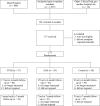A randomized controlled trial of two mail-based lifestyle interventions for breast cancer survivors
- PMID: 26887585
- PMCID: PMC4879070
- DOI: 10.1007/s00520-016-3129-y
A randomized controlled trial of two mail-based lifestyle interventions for breast cancer survivors
Abstract
Purpose: Although breast cancer survivors' lifestyle choices affect their subsequent health, a majority do not engage in healthy behaviors. Because treatment end is a "teachable moment" for potentially altering lifestyle change for breast cancer survivors, we developed and tested two mail-based interventions for women who recently completed primary treatment.
Methods: One hundred seventy-three survivors were randomly assigned to (1) Targeting the Teachable Moment (TTMI, n = 57), (2) Standard Lifestyle Management (SLM, n = 58), or (3) usual care (UC, n = 58) control group. Participants who were assigned to TTMI and SLM received relevant treatment materials biweekly for 4 months. Participants were assessed at baseline (T1, before randomization), post-treatment (T2, 4 months), and follow-up (T3, 7 months). Fruit and vegetable (F/V) intake, fat intake, and moderate-to-vigorous physical activity (MVPA) were assessed.
Results: Results showed promise for these mail-based interventions for changes in health behaviors: Survivors in TTMI (+.47) and SLM (+.45) reported increased F/V intake, whereas those in UC (-.1) reported decreased F/V intake from T1 to T2. Changes in minutes of MVPA from T1 to T2 were higher in SLM than UC and marginally higher in TTMI than UC. However, these differences were due to decreased MVPA in UC rather than increased MVPA in the intervention groups. There were no group differences regarding fat intake. Survivors reported high satisfaction and preference for mail-based interventions, supporting feasibility.
Conclusions: Mail-based lifestyle interventions for breast cancer survivors may benefit F/V intake and physical activity. Further testing and optimizing of these interventions is warranted.
Keywords: Dietary behaviors; Mail-based intervention; Physical activity; Teachable moment.
Figures
References
-
- Harrison S, Hayes SC, Newman B. Level of physical activity and characteristics associated with change following breast cancer diagnosis and treatment. Psycho-Oncology. 2009;18:387–394. doi:10.1002/pon.1504. - PubMed
-
- Holick C, Newcomb P, Trentham-Dietz A, et al. Physical activity and survival after diagnosis of invasive breast cancer. Cancer Epidemiol Biomarkers Prev. 2008;17:379–385. doi:10.1158/1055-9965.EPI-07-0771. - PubMed
-
- Holmes M, Chen W, Feskanich D, Kroenke C, Colditz G. Physical activity and survival after breast cancer diagnosis. JAMA. 2005;293:2479–2486. doi:10.1001/jama.293.20.2479. - PubMed
-
- Newton RU, Galvão DA. Exercise in prevention and management of cancer. Curr Treat Options Oncol. 2008;9:135–146. doi:10.1007/s11864-008-0065-1. - PubMed
Publication types
MeSH terms
Grants and funding
LinkOut - more resources
Full Text Sources
Other Literature Sources
Medical



